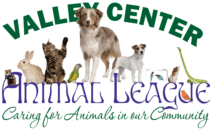The last meeting of your Valley Center Animal League produced a lively conversation about the mission of our weekly column. We certainly want to “inform you” regarding the goings-on of our organization, such as animals that we have rescued that are available for adoption, fundraisers that we are planning, the need for volunteers to foster and walk dogs, our feral cat program and our need to have individuals domesticate them, and more.
It becomes the responsibility of the person writing the article to present our “wants and needs” in a manner that keeps you, the reader, interested enough that you continue reading every column every week, and thus our objective becomes a matter of “entertaining” as well as “informing.”
In this column we shall, as in every article, attempt to find the balance, the “sweet spot” if you will, between informing and entertaining.
Somewhat coincidentally, the topic of this portion of the article is one that, on the surface, appears to be a formidable challenge to hold your interest, but here goes.
Pet food ingredient labels 101. (Told you it was going to be challenging.)
The U.S. Food and Drug administration regulates pet food ingredients, including treats and chews, and, in theory, ensures that packaging labels are accurate regarding what is in your pet’s food.
Furthermore, the ingredients list must list the percentage of the ingredients in order of the highest ingredient first. For example, many labels show that meat (beef, chicken even Mary’s little lamb) is listed first on a majority of pet food labels. Are we to believe that dry pet food contains 25 percent meat as some labels indicate? It’s a little hard to get past ingredient one and still have confidence that the rest of the ingredient list is accurate. However, it is probably safe to say that regardless of that dubious claim, the well-known brands are very likely to contain the nourishment our pets need.
Another aspect of the food we select is the cost. We certainly can’t do it by judging a product by its cost. For example, does the brand Science Diet offer your dog the most nutritious meal on the crowded shelf, or does its price and their marketing plan that makes it attainable through licensed veterinarians simply make us assume that it must be superior so we are willing to pay a premium price for it? An open question, is it not?
The Rachel Ray brand and others cover a multitude of choices marketed to appeal, but the price can be a little high, to say the least.
The research that this writer has done for this article indicates that pet food should not be judged on price and that less expensive brands are well suited to give one peace of mind that the vast majority, if not all, of the brands available will provide adequate nutrition for your animal because it’s clearly in the best interest of companies to do so.
As always, the league is searching for foster homes for our displaced animals. Housing them in kennels is not only expensive, but it is also undesirable for them to be caged. As a foster family, the league will reimburse you for any and all expenses and our fostering families consistently let us know that there is a lot of satisfaction to be gained for your efforts. Dog walkers are also needed.
Please contact Dawn Taylor at 393-5256 or Ray Sledge 305-3299 regarding the aforementioned needs or any questions about the League. If you are aware of feral cat colonies, contact me at 616-7487. We are a trap, neuter, return organization and always have the welfare of the cats as our priority. In addition, we will domesticate all kittens and any adults that show signs that they can be domesticated.
We meet on the third Wednesday of every month at the City Library, 314 E. Clay. Come say Howdy y’all!
Our can guy Don Bennet Jr. reports another aluminum can haul of a record-tying 340 pounds. Thanks to all of our loyal can providers.
Ed Varner is a member of the Valley Center Animal League.
